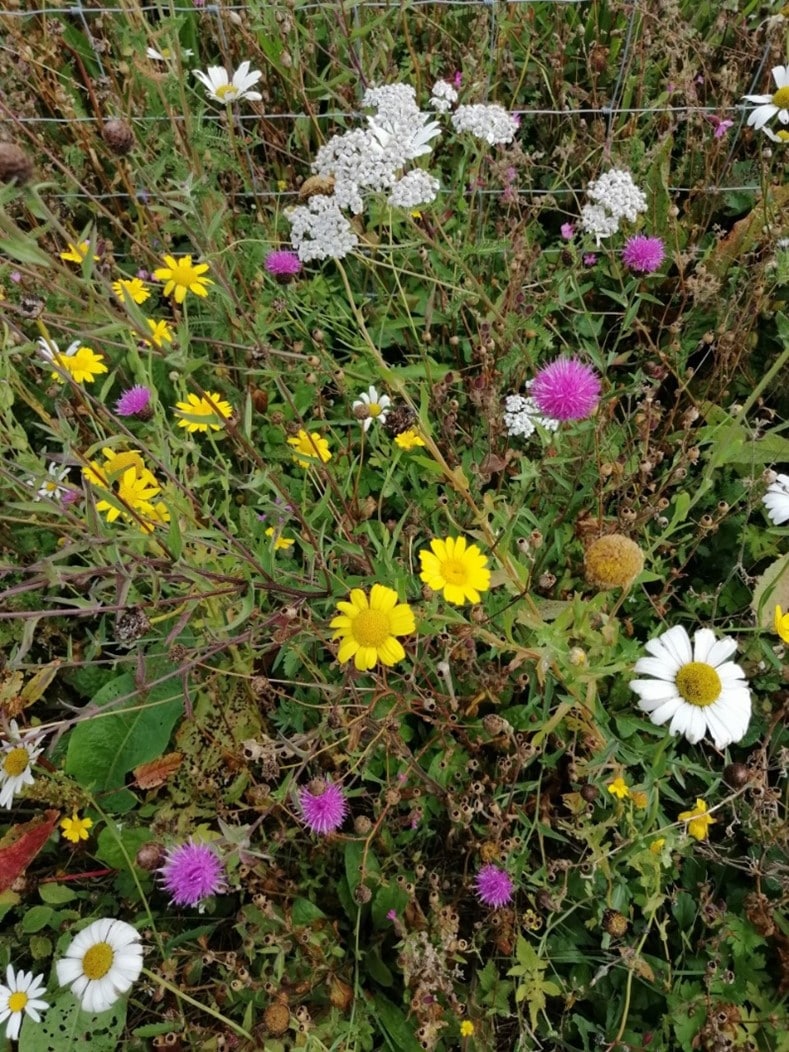I have lived on the edge of the Lake District for most of my life. As a teenager I took to the Lake District mountains – known as ‘fells’ – in search of what I thought was wildness. But back then I couldn’t articulate why I didn’t encounter much of anything in the way of wildlife – just the odd bird such as corvids, a few meadow pipits or summer migrant wheatears flitting amongst the boulders.
Golden eagles once nested here, but the landscape is now increasingly recognised as a place of loss, with nature falling away over decades.

Species rich grasslands, Kendal Fell. Credits: Karen Lloyd
World Heritage Site
In 2017 the Lake District was inscribed as a World Heritage Site (WHS) under the cultural landscapes category. I’m interested in thinking about what makes a landscape cultural in this time of climate change and biodiversity loss.
World Heritage (WH) say that both William Wordsworth and illustrator turned sheep farmer, Beatrix Potter (amongst others) are key Lake District figures who helped to influence the cultural landscape designation. But the inscription also enshrines the preservation of the sheep farmed in the upland landscape as a cultural phenomenon in its own right.
Hardy breeds of sheep are pastured on upland common grazings. This ‘tradition,’ however, has only existed in such a dominant way since the Second World War. Since then, because of the dominance of sheep grazing, many wild plants and pollinators have simply been unable to grow. Although sheep numbers were eventually reduced, frequently they remain too high.
But change is underway.
As part of my work at Lancaster University, together with my colleague Prof Charlie Gere, we have met farmers, land managers, conservationists, activists, NGOs, ecologists, and hydrologists. Our aim is to hold conversations about climate events and the loss of biodiversity here. Through that particular lens, we wanted to find the right kinds of questions to ask to locate both the problems and the solutions.
Nature is returning
We also wanted to consider how we might more usefully define the idea of cultural landscape at this point in time, and in this particular place. There is a momentum at work in a growing number of places where the land is once again being managed for nature. This includes the Vale of Rydal where Wordsworth once lived. Farmers there are being paid for environmental benefits. Hardy cattle now help to open the ground on the fellsides for seed dispersal, and trees and scrub species such as hawthorn thrive. Nature is returning. Elsewhere, such as at Gowbarrow Hall Farm on Ullswater and at Lowther Estates further east, major changes are also underway, with soil at the heart of restoration.
Land-army of pollinators
Under regenerative practices, cattle are ‘mob-grazed;’ they eat the grass in one area and are then moved to the next. Like this, the land can rest. The roots of grasses then form an open soil structure; one that is far more capable of absorbing and slowing rainfall. And in the absence of close grazing by sheep the wildflowers that have lain dormant in the soil return, bringing with them their attendant land-army of pollinators. At RSPB’s holdings at Haweswater and Swindale, lowland water meadows are once again allowed to flood and are fed by rivers that have been given back their natural curves, and the fellsides are once again home to wild plants and pollinators.

Restored hay meadows at Lowther Estates. Credits: Karen Lloyd
As an environmental writer, I am also interested in how we writers and other artists can communicate that positive change is possible and happening now. Early in my current residency with Lancaster’s Future Places Centre, I organised a new literary prize. The aim was to reward writing that navigates dynamic engagement with positive change in the natural world.
Future Places Reimagining Landscapes conference
Next, in July 2022, we’re hosting the Future Places Reimagining Landscapes conference to bring together artists, writers, ecologists, climate scientists, musicians and more to help us find new ways to communicate stories from the environment.
We cannot know what Wordsworth or Beatrix Potter might think, were they to return to the Lakes today, but we do know that they cared deeply for the more than aesthetic view of the landscape; a place without meadows and pollinators would have been an unimaginable thought for them. In this place as in many others, it is clear that nature and culture can absolutely travel together into the future.
To find out more about the Reimagining Landscapes conference click here.

Re-emergent wildflowers under regenerative farming, Gowbarrow Hall Farm. Credit: Karen Lloyd

